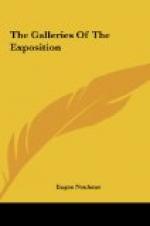Across the hall more of our academic school of painters are grouped. There is George de Forest Brush, the painter of the “Boston Madonna”, in some of his earlier illustrative canvases and a very fine pre-Raphaelite “Andromeda”. Brush is so contradictory at times that this small group is quite insufficient to do him full justice. Horatio Walker clings persistently to his conviction of the supremacy of the older methods, without giving any indication of contact with modern art. His superiority depends largely upon the human-interest stories he tells with wonderful breadth and sympathetic understanding. Charles W. Hawthorne’s canvases seem fumbled rather than painted. They are very hesitating in a technical way and are not sufficiently endowed with interest to grip one.
Gallery 57.
In another gallery in this neighborhood, Edwin Abbey’s art is presented very comprehensively in a number of large and small illustrations — canvases of more than passing interest. While they are largely illustrations, their interest is made permanent by reason of the subjective note which all of them have. Abbey’s intense imagination allowed him to carry a convincingness into his work which is largely responsible for the very high rank he attained. His art is not the art of an American in any sense. It is true he was born in Philadelphia, but a long and successful life spent in Europe has left on his work the imprint of an aristocracy foreign to our interest. In design, in colour, Abbey’s work is always supremely interesting, and with the astonishing development of illustration in America, it seems incredible that we should not have been able to make him return to the land of his birth.
Galleries fifty-five and fifty-six are modern in aspect and their contents came into this part of the building for practical reasons. Wedged in between older periods, it is difficult to combine them with the rest of modern American art, largely represented in the north side of the Palace.
Gallery 56.
Here two interiors in distinctly different styles stand out among the multitude. Marion Powers and Elizabeth Nourse add considerably to the achievement of our women artists in these well-painted canvases. Miss Powers is very original in an older school, while Miss Nourse displays all the technical dexterities of the present day. Hitchcock’s “Dutch Tulip Beds,” with figural staffage, remind one of a most original American who after a long struggle established himself with these colourful designs. His recent death came entirely too soon.
Gallery 55.
This room is intensely animated by Potthast’s six seashore sketches, which are composed and very sympathetic in their fine sunlight. Evelyn McCormick’s “Monterey Custom House” is no less sunny, and conscientiously studied in detail.
Gallery 65.




